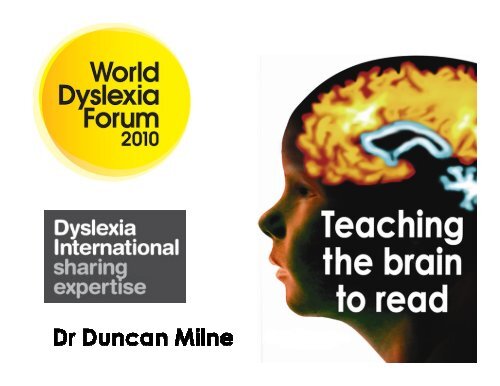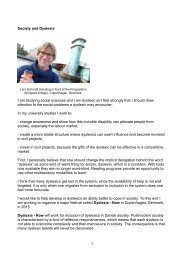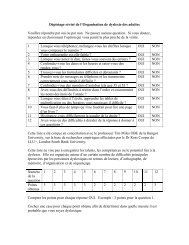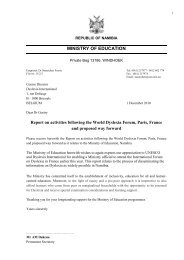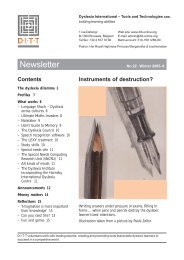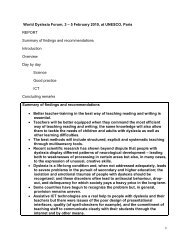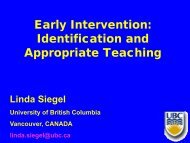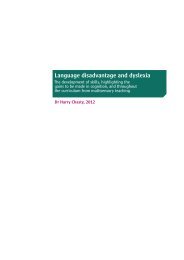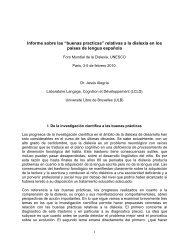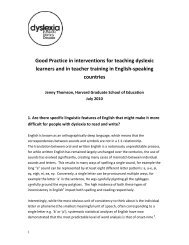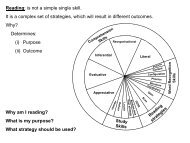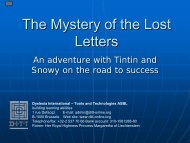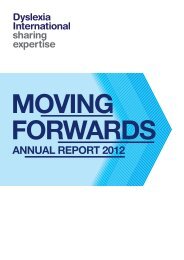Dr Duncan Milne - Dyslexia International
Dr Duncan Milne - Dyslexia International
Dr Duncan Milne - Dyslexia International
Create successful ePaper yourself
Turn your PDF publications into a flip-book with our unique Google optimized e-Paper software.
eading circuits<br />
brain imaging<br />
simulations<br />
learn Neuro-Linguistics<br />
in just 5 words!<br />
discuss how dyslexia<br />
is represented<br />
<strong>Dr</strong> <strong>Duncan</strong> <strong>Milne</strong><br />
Neuropsychologist
“minlop”<br />
Nonword repetition
Nonword repetition<br />
Nonword repetition<br />
(in illiterates)<br />
Hospital de Santa Maria
The evolution of literacy<br />
2,000,000 150,000 4,000<br />
today<br />
fish<br />
Visual<br />
Auditory<br />
Reading<br />
circuits
Neuro-linguistic word<br />
1<br />
word
Introducing Mr. Brain…<br />
Phonemic<br />
Awareness<br />
Auditory<br />
Phoneme<br />
Sound<br />
Pronunciation<br />
“word”<br />
Letter shape<br />
Visual<br />
Graphemic<br />
Awareness<br />
Word form<br />
word
matching<br />
isolating<br />
blending<br />
segmenting<br />
deleting<br />
substituting<br />
Syllable Onset / Rime Phoneme
Neuro-linguistic word<br />
2
Logographic Stage<br />
Auditory<br />
Pronunciation<br />
“stop”<br />
STOP<br />
Visual<br />
Word form<br />
“stop”
Type II activation (sources location):<br />
Strongest for visible words<br />
• ~ 150ms after stimulus onset<br />
• left predominant occipito-temporal<br />
• increases with string length<br />
• = letter-string specific
Neuro-linguistic word<br />
3<br />
καλησπερα
Phonological stage<br />
“k a li spe ra”<br />
“kalispera”<br />
Auditory<br />
Phoneme<br />
Sound<br />
Pronunciation<br />
κ<br />
α λη<br />
σ<br />
π<br />
ε<br />
ρ<br />
α<br />
Letter shape<br />
Visual<br />
Word form<br />
<br />
καλησπερα<br />
“kalispera”
Orthographic Stage<br />
“kuh-aah-tuh”<br />
“cat”<br />
Auditory<br />
Phoneme<br />
Sound<br />
Pronunciation<br />
c<br />
a<br />
t<br />
cat<br />
Letter shape<br />
Visual<br />
Word form<br />
<br />
cat<br />
“cat”
Lexical access<br />
Auditory<br />
“cat”<br />
Pronunciation<br />
cat<br />
Visual<br />
Word form<br />
cat<br />
“cat”
Unknown words<br />
•unknown words > words<br />
• for sounding out<br />
Mature Reader<br />
Known words<br />
• words > unknown words<br />
•activation increases with age
was
her
first
day
school
she
drank
cold
glass
Neuro-linguistic word 4<br />
nails
She drank a cold glass of nails
PHONICS<br />
Strategies are<br />
learned for<br />
decoding new<br />
words<br />
Whole language<br />
Words are taught in<br />
context with a goal of<br />
increasing overall<br />
understanding
Neuro-linguistic word<br />
5<br />
fough
fough<br />
fow<br />
“fof”<br />
“fuf”<br />
“fou”<br />
“foe”<br />
cough<br />
“fou”<br />
plough<br />
rough<br />
cow<br />
how<br />
now<br />
tow<br />
flow<br />
grow<br />
“foe”<br />
“foo”<br />
down<br />
snow<br />
dough<br />
through
Segmentation Example<br />
Consistency<br />
(spelling / sound)<br />
Initial<br />
Consonant<br />
Vowel<br />
Final<br />
consonant<br />
‘s’ soap, sail,<br />
sea<br />
‘u’ fun, cut,<br />
bull<br />
‘p’ tap, cup,<br />
leap<br />
96%<br />
51%<br />
91%<br />
CV -<br />
‘ba’ in bat,<br />
ball, bar<br />
- VC ‘ut’ in hut,<br />
nut, put<br />
52%<br />
77%
WORD READING ACROSS LANGUAGES<br />
94%<br />
Shallow<br />
95%<br />
98%<br />
Finnish<br />
95%<br />
Greek<br />
Italian<br />
71%<br />
Spanish<br />
Portuguese<br />
French<br />
English<br />
Deep<br />
73%<br />
33%<br />
95%<br />
79%<br />
95%<br />
97%<br />
95%<br />
97%<br />
97%<br />
Seymour et al., 2003
1<br />
4<br />
5<br />
word<br />
nails<br />
fough<br />
2<br />
3<br />
καλησπερα
Balanced literacy<br />
Phonemic<br />
Awareness<br />
Auditory<br />
Phoneme<br />
Sound<br />
Pronunciation<br />
Whole<br />
language<br />
Analytic<br />
Phonics<br />
Synthetic<br />
Phonics<br />
Letter shape<br />
Visual<br />
Word form<br />
Graphemic<br />
Awareness
The Learning Difficulties Constellation<br />
attention deficit<br />
dysgraphia<br />
dysorthographia<br />
dyslexia<br />
dyspraxia<br />
dysphasia<br />
dyscalculia
Dyseidetics<br />
“kuh-aah-tuh”<br />
Irregular word reading<br />
Phonic spelling patterns<br />
Auditory<br />
Phoneme<br />
Sound<br />
c<br />
a<br />
t<br />
“cat”<br />
Pronunciation<br />
r<br />
cat<br />
Letter shape<br />
Visual<br />
Word form<br />
cat<br />
“cat”
Dysphonetics<br />
“kuh-aah-tuh”<br />
“cat”<br />
Auditory<br />
Phoneme<br />
Sound<br />
Pronunciation<br />
Nonword reading<br />
(PPhE) Spelling patterns<br />
rc<br />
a<br />
t<br />
cat<br />
Letter shape<br />
Visual<br />
Word form<br />
cat<br />
“cat”
Distal Cause Proximal Cause Intervention<br />
Dysphonetic<br />
BIOLOGY<br />
<strong>Dyslexia</strong><br />
-connectivity / wiring<br />
-constellation<br />
Poor grapheme-tophoneme<br />
conversion<br />
(decoding)<br />
Phonological<br />
•Phonemic Awareness<br />
•Synthetic Phonics<br />
Poor Reading<br />
ENVIRONMENT<br />
- orthography<br />
- exposure to print<br />
Dyseidetic<br />
Poor memory and<br />
perception of whole<br />
word configurations<br />
Orthographic<br />
•High Frequency words<br />
•Irregular words<br />
•Mnemonics<br />
•Contextual Reading
Phonemic<br />
Awareness<br />
Synthetic phonics<br />
Phonemic Clues<br />
Auditory<br />
Audio-Visual<br />
Phoneme<br />
Sound<br />
Colourcoded<br />
letters<br />
Moveable<br />
letters<br />
Analytic<br />
phonics<br />
Letter shape<br />
Visual<br />
problems sounding<br />
out new words


